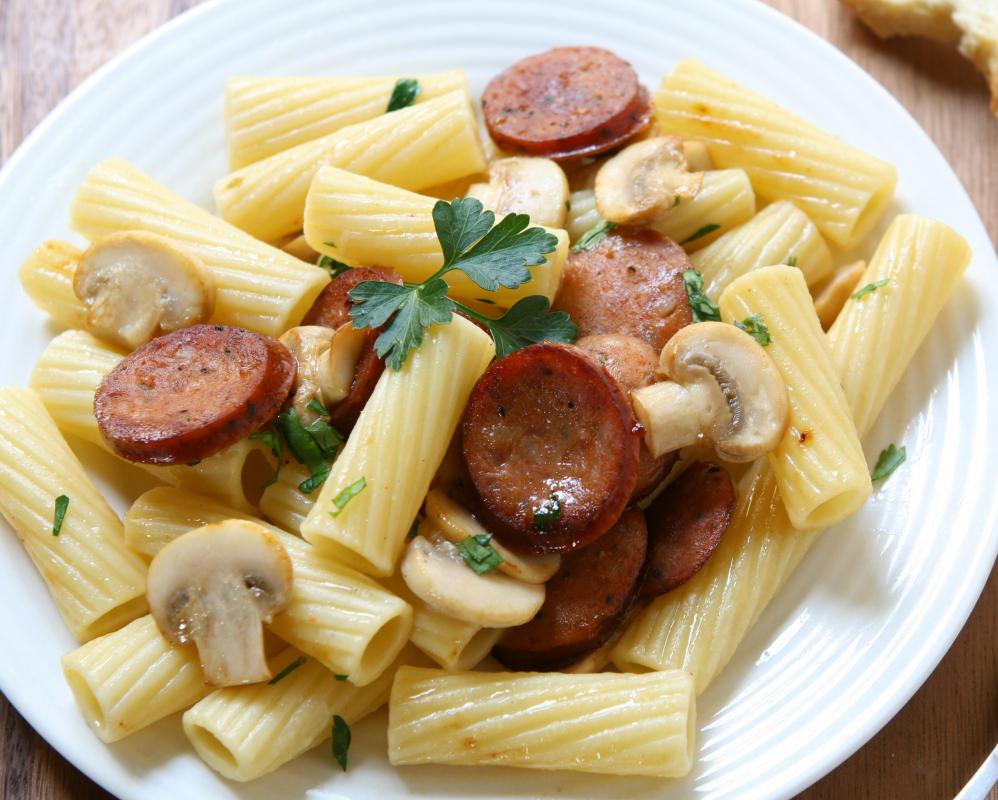At DelightedCooking, we're committed to delivering accurate, trustworthy information. Our expert-authored content is rigorously fact-checked and sourced from credible authorities. Discover how we uphold the highest standards in providing you with reliable knowledge.
What are Some of the Different Types of Pasta?
Pasta comes in a wide variety of shapes and sizes, developed in various parts of Italy to go with a myriad assortment of sauces. In addition to strips, it can also be found molded into fantastical shapes, and it is made with different ingredients, depending on the intended purpose and the region in which it is being made. Basic pastas can be divided into two types: egg noodles, made with flour, salt, eggs, and oil; or regular, made with water, salt, and flour. Different types of flour including whole wheat, low protein, and conventional white are used in varying proportions in different parts of the world.
In general, the type of pasta used is dependent on the sauce. Thicker sauces go better with shaped pasta, because it will be able to hold and carry the sauce more effectively. Thinner sauces, on the other hand, go better with small, delicate strips like thin egg noodles or capellini. In addition, you may want to consider who is consuming the pasta when you pick out a type, as children find it easier to eat shapes that can be easily fit onto forks or in the bowl of a spoon.

Pasta cut into strips includes capellini, or angel hair, the thinnest type. Thicker varieties such as spaghetti, linguini, and fettucini are also available. Although these thicker shapes can be used with more robust sauces, they do not fare well with chunky ones, because the chunks tend to slide off the pasta and end up in the bottom of the bowl. They are ideal with cream sauces, pesto, lemon sauces, thin red sauces, or served with olive oil, garlic, and Parmesan. If you serve the pasta with a fork and spoon, diners will find it far less challenging to eat.

The assortment of shapes can be rather intimidating, especially in a market which carries a lot of Italian imports. Some common shapes include macaroni, small pasta tubes which are suited to baking and cream sauces; farfalle, or bow ties; rotini, or twisted noodles; rotelle, or wagon wheels,; and penne, larger tube shaped pasta. Rotini is also available in a longer strip form, in which case it is called fusilli. These shapes are all excellent in baked dishes, or served with dense, chunky sauces. Some is specifically designed for baking, as is the case with manicotti and lasagna. In both instances, the pasta is large, sturdy, and thick, to stand up to boiling, stuffing, and baking.
AS FEATURED ON:
AS FEATURED ON:






















Discussion Comments
I have no idea how old this is, but if it's any use, I'll weigh in. When I make pasta, I use the following recipe. I've found it's what strikes the best balance between flavor and ease to work with.
1 cup white flour
1/2 cup whole wheat flour
3 large eggs
2 tablespoons olive oil
1 teaspoon coarse salt
You have to knead it for a while, or throw it in a food processor with a dough attachment and then knead it for much less time, but it's worth it.
@bigmetal: Well, technically regular pasta is made with wheat as well. Do you mean whole wheat? If so, yes, whole wheat can be a bit trickier to use than regular processed wheat is.
Because it isn't as refined, whole wheat has a slightly rougher texture, and makes for tougher pasta dough (harder to roll out) as well as noodles with a heavier texture over all. It's not a huge difference, but it's noticeable. Whole wheat pasta has a richer, more nutty flavor than white flour noodles do -- many people prefer whole wheat for the results, even if it's a bit more trouble to prepare.
is it more difficult to make your own homemade wheat pasta than it is to make regular pasta?
Post your comments